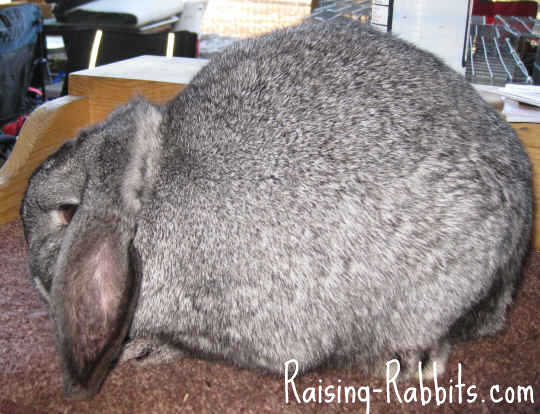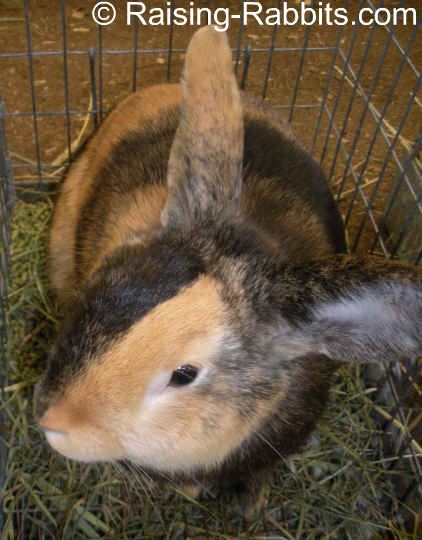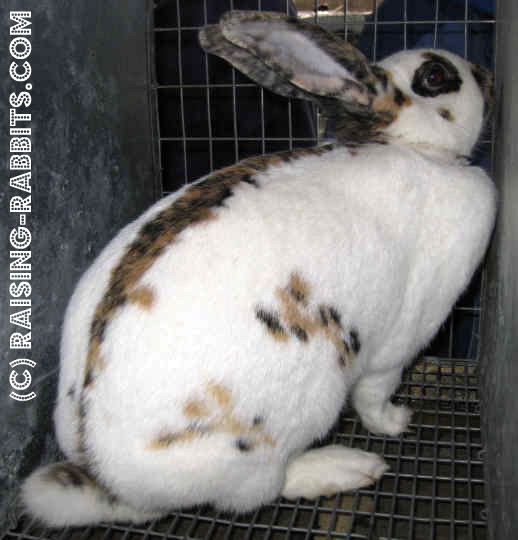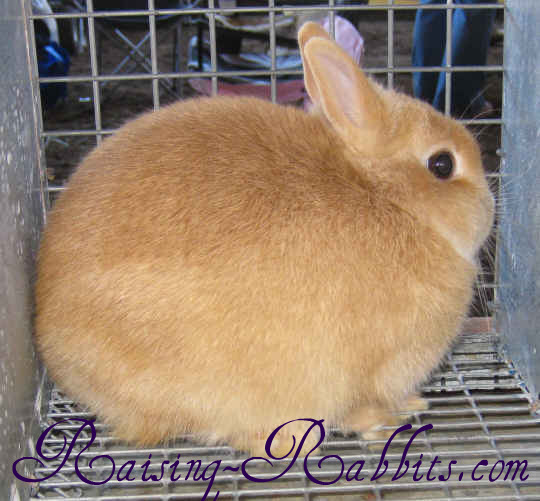E Locus Rabbit Colors
E
locus rabbit colors. Here is rabbit coat color genetics information pertaining to the 2
‘E’ locus rabbit color genes carried by domestic rabbits, including the sneaky
Es steel gene.
The 2 genes at the 'E' locus manage the quality and the quantity of the black pigment in a rabbit's coat. 'E' stands for extension (or non-extension) of the black pigment on the fur shaft.
There are 4 genetic options at the 'E' locus, presented here in their order of dominance:
'Es'
Es is said to be dominant, but as we
will see, that dominance is incomplete. It is nevertheless definitely
overpowering. It over-produces black pigment on the hair shaft, invading and
taking over the normal pattern of color.
A correct 'steel' coloration requires
a single Es and an E (EsE). Despite
incomplete dominance, we list Es first, as it overpowers the
other 'E-locus' rabbit color genes.
 Es gene: White-tipped steel
Es gene: White-tipped steelTo identify a steel rabbit, look for the rabbit's undercolor extending all the way up the hair shaft, wiping out the ring, and on an agouti, no white belly.
The steel gene can be a bugger, because it seems to be able to hide itself amongst the other ‘e’ genes. More on Steel Rabbit Genetics here...
'E'
E is the original dominant gene at the E locus, and codes for correct presentation of black pigment.
Most rabbits carry 'EE.'
'ej'
 'ej' gene: Harlequin coloration
'ej' gene: Harlequin coloration Rhinelander Rabbit
Rhinelander Rabbitej is dominant to 'e' but recessive to 'E.'
ej produces the brindled pattern of harlequins and magpies - some areas of over-produced black, and some areas of under-produced black pigmentation. Pictured above left is a well-marked harlequin rabbit.
If you add the dominant 'En' broken gene to the mix (En has its own 'En' locus and is not a part of the 'E' locus), the harlequin becomes a broken tri-colored rabbit, such as the Rhinelander (above right)
Without the 'En' broken gene, this Rhinelander would look very much like the Harlequin rabbit.
'e'
e is recessive - No extension of black pigment at all. Think oranges, reds, and fawns. When its effect is imperfect possibly due to modifiers, you'll get a remaining bit of 'smut' or 'soot' on the rabbit.
This Cinnamon rabbit is a self black rabbit with 2 copies of
the ee non-extension gene, which wiped out nearly all of the
black pigment. In the case of this rabbit, modifiers allow a touch of remaining
black on the corners of the rabbit - ears, nose, and around the tail and feet.
'E' Genotypes

- Steels = EsE (EsEs, a double-steel, is too dark for true steel coloration - see below)
- Normally colored rabbits = EE, Eej, or Ee
- Harlequins = ejej or eje
- Red/orange/fawn = ee
Pictured at right is an orange Netherland Dwarf, an agouti rabbit with the black pigment nearly entirely eliminated. Without its 'ee' genes, this rabbit would be a chestnut (or possibly a chocolate) agouti.
Controversy with E Locus Rabbit Colors
I've heard tell of an Ed gene that is reported to be even stronger than the Es gene. The jury is still out, as far as we know, relative to whether or not this is true.
We rather doubt it. We think that the 'Ed' is really a double set of 'Es' genes -- 'EsEs' -- which would greatly strengthen the steel effects. Remember, the true 'steel' rabbit comes with just one steel gene and a normal 'E' gene (EsE). If you double the Es and add in some darkening modifiers, it's easy to see why some would figure there must be a gene stronger than the steel 'Es.'
Is there a geneticist out there that can verify the existence of an 'Ed' gene? Or confirm our doubts? If so, please comment below, or contact us.
We've pictured several E locus rabbit colors, but other colors can result from actions of the E locus also, once you factor in the A, B, C, and D genes. For example, the action of the B locus might reduce the intensity of the black pigment, so the rabbit becomes a chocolate-based animal. The action of the E locus affects the black pigment, which in this rabbit looks chocolate in color. You'd end up with chocolate steels, or chocolate harlequins, etc.
Hopefully it will now be easier to recognize the actions of the E locus rabbit color genes.
More on Steel Rabbit Genetics here
Go from E Locus Rabbit Colors to Rabbit Coat Color Genetics
Double-Value Guarantee
Our policy is to always OVER-deliver
on value,
which is why your purchase is fully covered by our
Double-Value
Guarantee.
Go ahead - take any of our e-books for a test drive. Peruse our detailed informational and educational e-books. Examine our plans for building rabbit cages, runs, or metal or PVC hutch frames. Check out the Rabbit Husbandry info e-books.
If you aren't completely satisfied that your e-book purchase is worth at least double, triple or even quadruple the price you paid, just drop us a note within 45 days, and we'll refund you the entire cost. That's our Double-Value Guarantee.
Note: When you purchase your
e-books, they will be in PDF format, so you can download them to any device that
supports PDF format. We advise making a back-up copy to a drive or cloud
account. If the books are lost, you can also purchase another copy from Raising-Rabbits.











New! Comments
Have your say about what you just read! Leave me a comment in the box below.